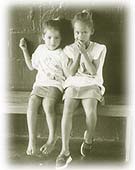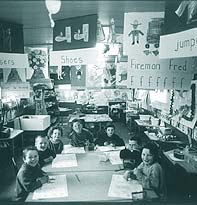![]()
|
Practical Step to promote Anti-Racism Activities and Actions for Students and Youth Groups - An Anti-Racist Classroom |


 AN
ANTI-RACIST CLASSROOM
AN
ANTI-RACIST CLASSROOM
Ensuring that our children are educated in an atmosphere that challenges and helps overcome racist views can begin with such simple measures as the teacher's choice of posters on the classroom walls and the choice of projects for school work.
The work in the anti-racist classroom should be reinforced by the anti-racist school:
- The school should have a clear equality policy and code of practice, at educational, administrative levels as well as in its relations with the community
- Resources should be sought and allocated to support the work in the classroom
- In-service anti-racist training should be provided for all staff, educational and administrative
- Decisions should be equality-proofed as a matter of course
- The educational and administrative staff should, where possible, be multi-ethnic
- Mechanisms should exist to monitor and evaluate the implementation of equality policies
What does it look like?
An actual physical "anti-racist classroom" is a big resource in promoting the overall anti-racist work of the school. Images used by teachers in their work should challenge stereotypes (both "positive" and "negative") and encourage a non-patronising celebration of diversity.
Posters, maps, games, photographs, drawings etc. help the teacher communicate the importance of different ethnic groups to overall human civilisation and its body of knowledge and culture. These will place the dominant culture of the majority students in perspective and thereby challenge the concept of its "normality" (and minority cultures' abnormality).
For example, Peter's Projection map of the world would be used. Jigsaw puzzles, posters etc. would, without specific reference to their ethnicity, include images of people from different ethnic groups. Toys, dolls, games etc. would be multi-ethnic. The terms of reference of projects and their subsequent displays would assume a multi-ethnic society and acknowledge in a simple way the power differential which exists.
What happens in an anti-racist classroom?
Whether the student body is multi-ethnic or not, the work of the class should be inter-cultural. All members of the class live in a multi-ethnic society and a multi-ethnic world and need an education which facilitates effective communication across cultural barriers. The first step in learning this effective communication is to become aware of one's own ethnicity. Students should learn about how their own culture has evolved to the present point and how the way it has decided to organise itself is a response to particular circumstances which are variable.
Moving out from that starting point, the classroom curriculum should be intercultural. So no matter whether it is geography, maths, Irish, history or whatever, it will be contextualised in the reality of a multi-cultural world. For example the students should learn about the contribution of non-European cultures to mathematics. The many examples used in problem solving, which draw on examples from everyday life, should include a diversity of experience. In Irish class there is an obvious opportunity for exploring the different ways different cultures communicate similar needs. It also offers an opportunity to discuss minority languages and cultural domination.
Example-giving is a core part of the teaching process. Without any additional resources teachers could introduce many intercultural topics by carefully choosing the examples they use. By choosing a diversity of examples it could become normal to think of the world around the students as multi-ethnic, as well as challenging the stereotypes. The choice of textbooks and other teaching resources is an area over which the teacher has a lot of control. Where possible these resources should be intercultural i.e. challenging stereotypes, celebrating diversity and acknowledging the existence of racism.
The creation of a safe school environment for students is in recent times being given the priority it deserves. Tackling sexual abuse and bullying are now firmly on the agenda for educators. Another dimension to this environment is the safety of the student's cultural identity. School should reinforce and support this identity rather than demean it, which is obviously more likely to happen in the case of minority ethnic students. School is all too often part of an assimilation programme which feels threatened by cultural diversity. The classroom teacher can go a long way to countering this by encouraging a classroom atmosphere which says it's good to be yourself, it's OK to be different, everyone is different in some way, and variety is the spice of life.
Of course many students will bring a certain prejudicial baggage with them to the classroom. They may use language which is racist or express opinions which are based on prejudice. They should not be castigated for having these opinions. Rather, as issues arise in the classroom the teacher can use these as a focus for dealing with the prejudices, stereotypes which exist rather than running away from real issues or brushing them aside in some way.
The teacher can also encourage students to bring their critical faculties to bear on issues external to the classroom, in the school, in the community, country or world-wide. Bringing the news into the classroom and analysing it from an anti-racist perspective would indeed be a worthwhile achievement of any teacher.
The role of peer education is highly important in the arena of anti-racist education. The students should be facilitated to challenge each others' attitudes and actions in a safe, non-threatening way. Pupils can contribute to the anti-racist classroom by sharing the diversity of experience that exists, by sharing their particular stories. With the support of the teacher and each other they can become more aware of the language they use, the assumptions they make and the prejudices they hold.
Many minority ethnic students underachieve or drop out from school. In the case of Travellers those who enter second level rarely complete the first year. The impediments that minority ethnic students encounter require dedicated support if they are to be overcome and if they are to participate fully at school.
Non-stigmatising, non-intrusive, background support to pupils from minority ethnic groups which monitors progress, relations with other students/teachers, expectations of teachers and other issues, needs to be in place (such as a mentor system).
Low expectations from teachers of students from minority ethnic backgrounds is a common complaint from parents. This needs to be addressed through in-service anti-racist training and other methods including monitoring.
Particular initiatives are required to promote and support parent involvement from within minority ethnic groups. Outreach initiatives, effective home-school liaison and creative open days can all help. Affirmative action in relation to their involvement on Boards of Management and School Committees is also important.
| Calypso
Productions South Great George's St. Dublin 2, Ireland T (353 1) 6704539 F (353 1) 6704275 calypso@tinet.ie |
![]()
— Welcome
- About - Productions
- Theatre and Social Change -
— Racism - Refugees
and Asylum Seekers - Prisons -
![]()